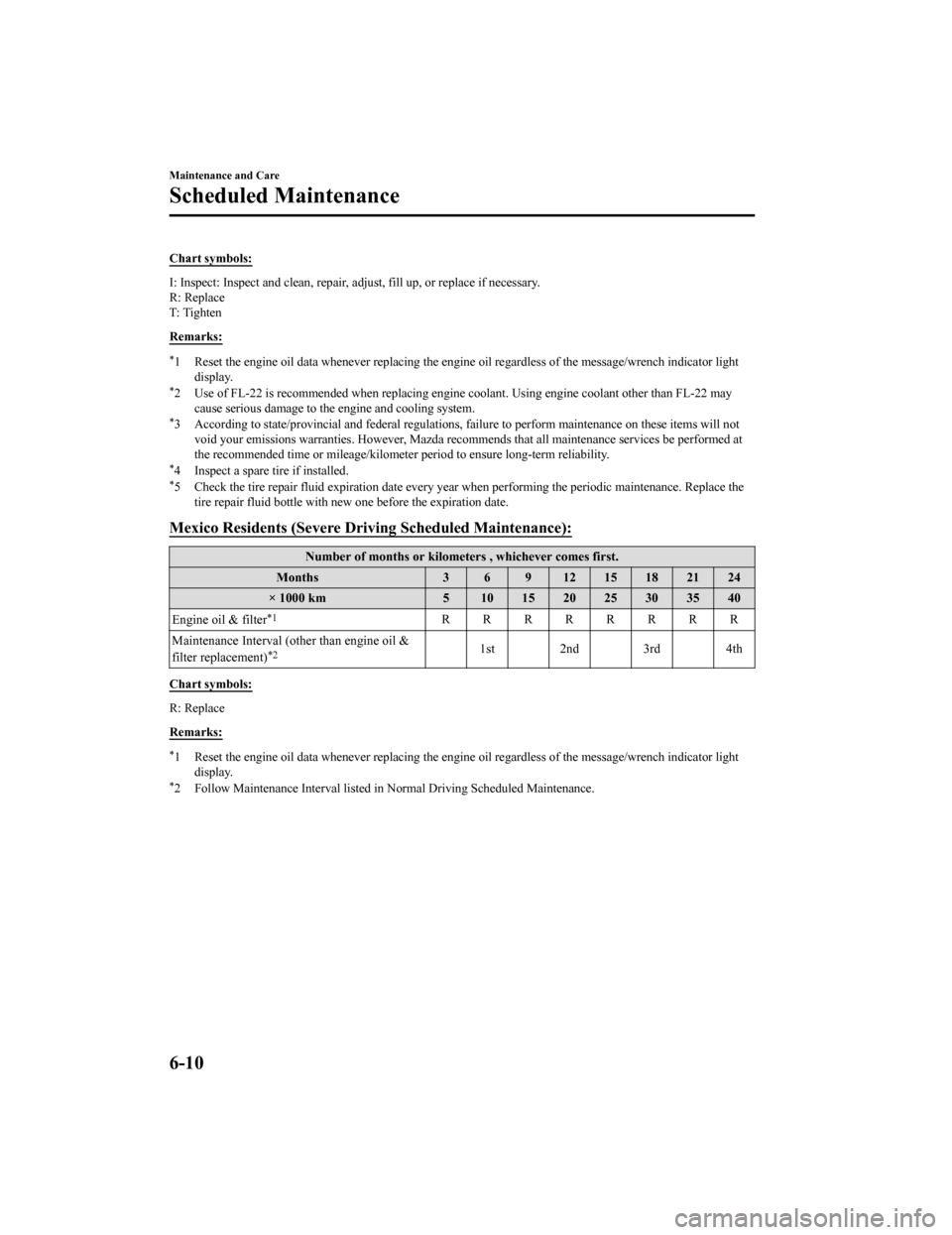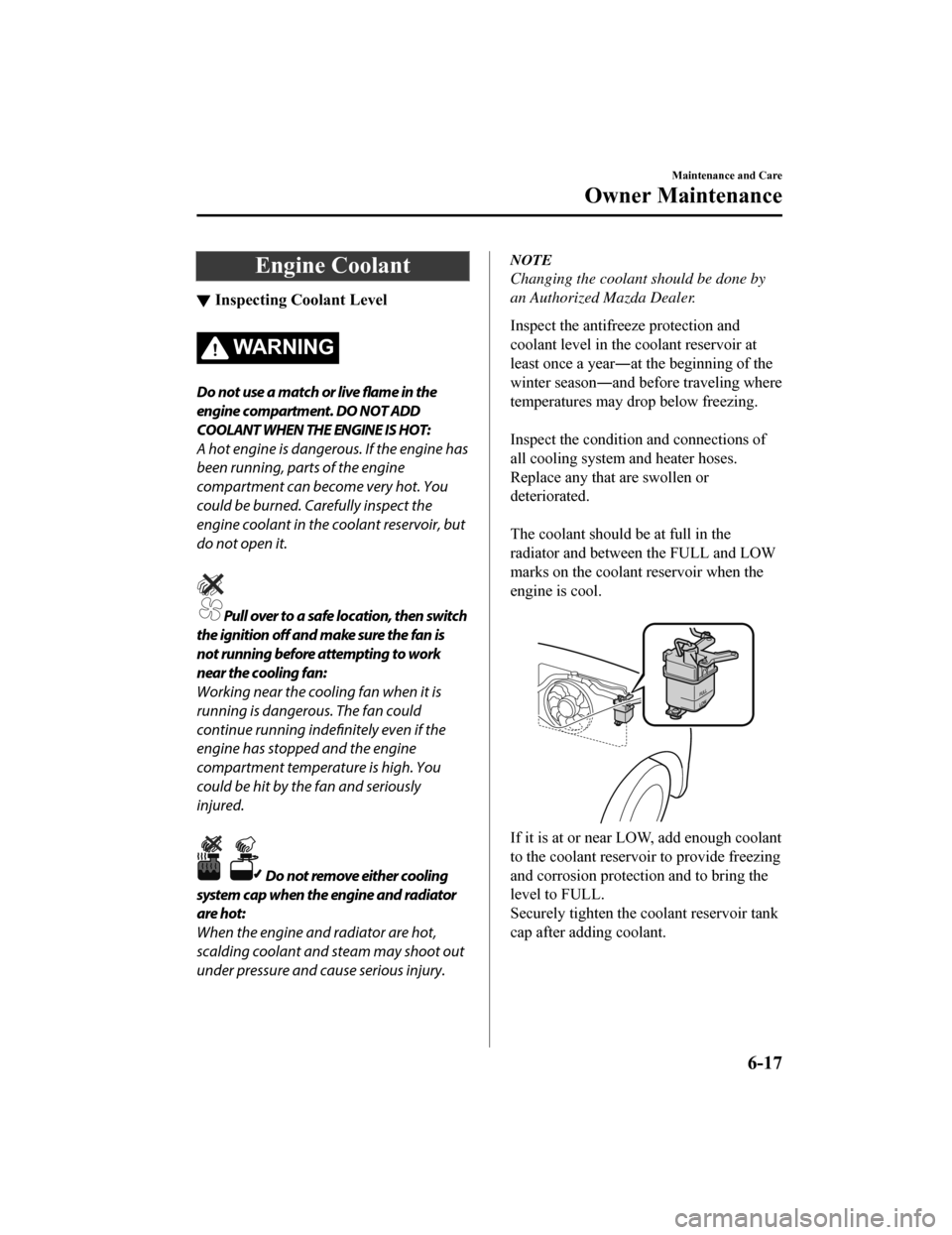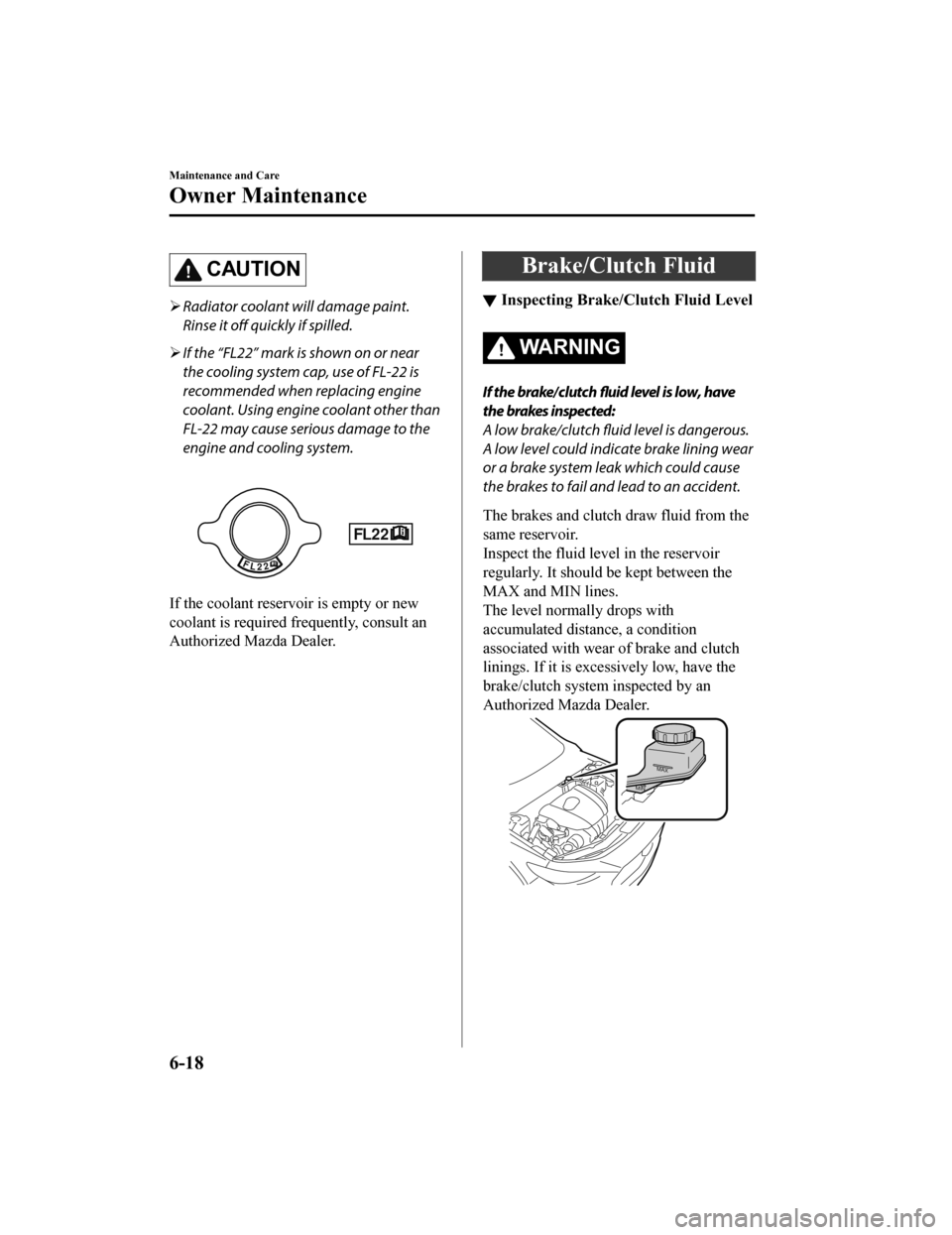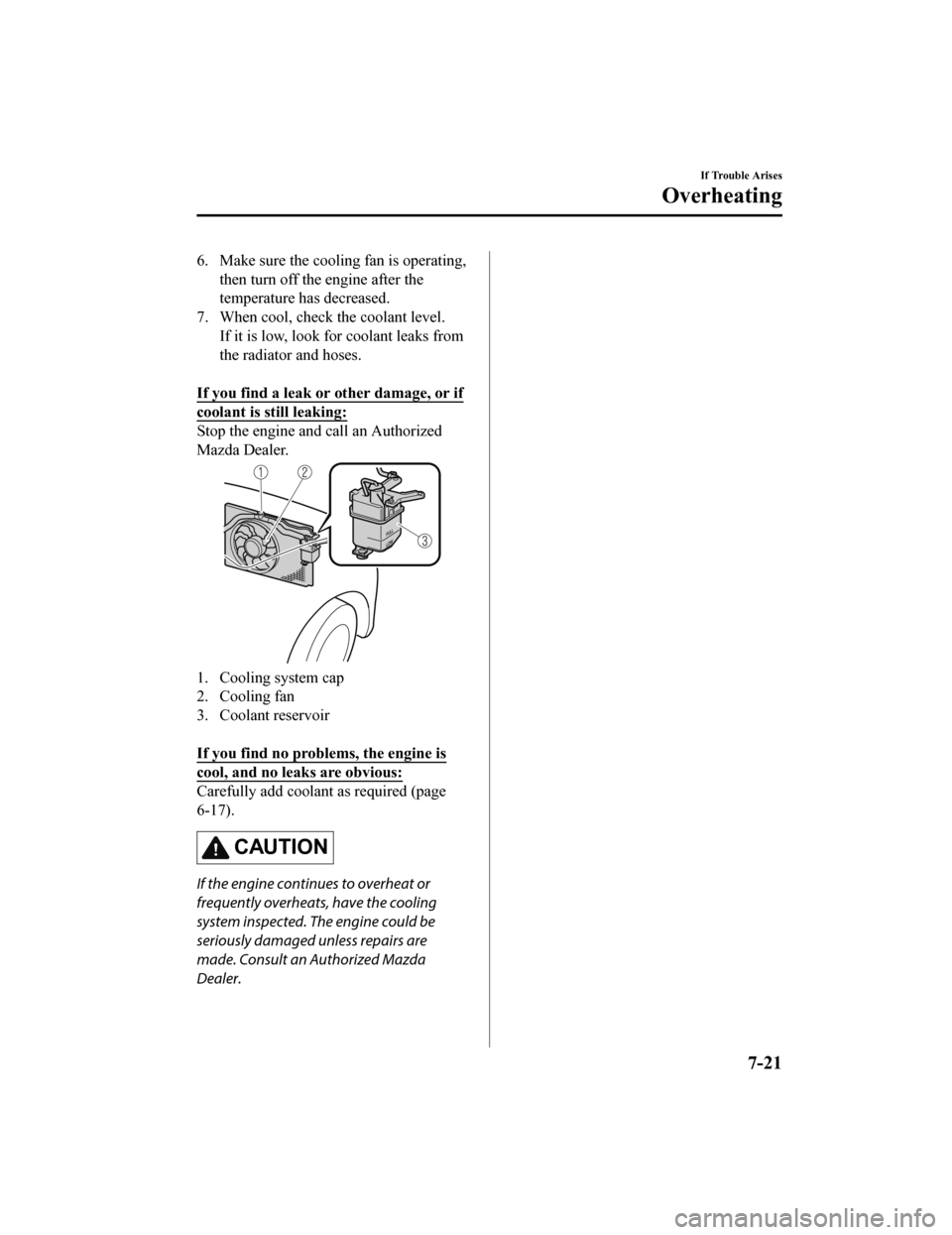cooling MAZDA MODEL 3 HATCHBACK 2019 (in English) User Guide
[x] Cancel search | Manufacturer: MAZDA, Model Year: 2019, Model line: MODEL 3 HATCHBACK, Model: MAZDA MODEL 3 HATCHBACK 2019Pages: 592, PDF Size: 12.19 MB
Page 434 of 592

Chart symbols:
I: Inspect: Inspect and clean, repair, adjust, fill up, or repl ace if necessary.
R: Replace
T: Tighten
Remarks:
*1 Reset the engine oil data whenever replacing the engine oil re gardless of the message/wrench indicator light
display.
*2 Use of FL-22 is recommended when replacing engine coolant. Using engine coolant other than FL-22 may
cause serious damage to the engine and cooling system.
*3 According to state/provincial and federal regulations, failure to perform maintenance on these items will not
void your emissions warranties. H owever, Mazda recommends that all maintenance services be performed at
the recommended time or mileage/kilometer period to ensure long -term reliability.
*4 Inspect a spare tire if installed.*5 Check the tire repair fluid expiration date every year when performing the periodic maintenance. Replace the
tire repair fluid bottle with ne w one before the expiration dat e.
Mexico Residents (Severe Dri ving Scheduled Maintenance):
Number of months or kilometers , whichever comes first.
Months 3 6 9 12 15 18 21 24
× 1000 km 5 10 15 20 25 30 35 40
Engine oil & filter
*1RRRRRRRR
Maintenance Interval (other than engine oil &
filter replacement)
*21st 2nd 3rd 4th
Chart symbols:
R: Replace
Remarks:
*1 Reset the engine oil data whenever replacing the engine oil re gardless of the message/wrench indicator light
display.
*2 Follow Maintenance Interval lis ted in Normal Driving Scheduled Maintenance.
Maintenance and Care
Scheduled Maintenance
6-10
Mazda3_8HE9-EA-18K_Edition1 2018-10-17 19:05:10
Page 436 of 592

If you must run the engine while working
under the hood, make certain that you
remove all jewelry (especially rings,
bracelets, watches, and necklaces) and all
neckties, scarves, and similar loose clothing
before getting near the engine or cooling
fan which may turn on unexpectedly:
Working under the hood with the engine
running is dangerous. It becomes even
more dangerous when you wear jewelry,
loose clothing or have long hair or a long
beard.
Either can become entangled in moving
parts and result in injury.
Pull over to a safe location, then switch
the ignition off and make sure the fan is
not running before attempting to work
near the cooling fan:
Working near the cooling fan when it is
running is dangerous. The fan could
continue running indefinitely even if the
engine has stopped and the engine
compartment temperature is high. You
could be hit by the fan and seriously
injured.
Do not leave items in the engine
compartment:
After you have finished checking or doing
servicing in the engine compartment, do
not forget and leave items such as tools or
rags in the engine compartment.
Tools or other items left in the engine
compartment could cause engine damage
or a fire leading to an unexpected accident.
Hood
▼ Hood
WA R N I N G
Always check that the hood is closed and
securely locked:
A hood that is not closed and securely
locked is dangerous as it could fly open
while the vehicle is moving and block the
driver's vision which could result in a
serious accident.
▼Opening the Hood
1. With the vehicle
parked, pull the
release handle to unlock the hood.
2. Insert your hand into the hood opening, slide the latch lever to the
left, and lift up the hood.
Maintenance and Care
Owner Maintenance
6-12
Mazda3_8HE9-EA-18K_Edition1 2018-10-17 19:05:10
Page 438 of 592

Engine Compartment Overview
▼Engine Compartment Overview
1. Engine coolant reservoir
2. Engine oil dipstick
3. Brake/Clutch fluid reservoir
4. Battery
5. Fuse block
6. Cooling system cap
7. Engine oil-filler cap
8. Windshield washer fluid reservoir
Maintenance and Care
Owner Maintenance
6-14
Mazda3_8HE9-EA-18K_Edition1
2018-10-17 19:05:10
Page 441 of 592

Engine Coolant
▼Inspecting Coolant Level
WA R N I N G
Do not use a match or live flame in the
engine compartment. DO NOT ADD
COOLANT WHEN THE ENGINE IS HOT:
A hot engine is dangerous. If the engine has
been running, parts of the engine
compartment can become very hot. You
could be burned. Carefully inspect the
engine coolant in the coolant reservoir, but
do not open it.
Pull over to a safe location, then switch
the ignition off and make sure the fan is
not running before attempting to work
near the cooling fan:
Working near the cooling fan when it is
running is dangerous. The fan could
continue running indefinitely even if the
engine has stopped and the engine
compartment temperature is high. You
could be hit by the fan and seriously
injured.
Do not remove either cooling
system cap when the engine and radiator
are hot:
When the engine and radiator are hot,
scalding coolant and steam may shoot out
under pressure and cause serious injury.
NOTE
Changing the coolant should be done by
an Authorized Mazda Dealer.
Inspect the antifreeze protection and
coolant level in the coolant reservoir at
least once a year―at the beginning of the
winter season―and before traveling where
temperatures may drop below freezing.
Inspect the condition and connections of
all cooling system and heater hoses.
Replace any that are swollen or
deteriorated.
The coolant should be at full in the
radiator and between the FULL and LOW
marks on the coolant reservoir when the
engine is cool.
If it is at or near LOW, add enough coolant
to the coolant reservoir to provide freezing
and corrosion protec tion and to bring the
level to FULL.
Securely tighten the coolant reservoir tank
cap after adding coolant.
Maintenance and Care
Owner Maintenance
6-17
Mazda3_8HE9-EA-18K_Edition1 2018-10-17 19:05:10
Page 442 of 592

CAUTION
Radiator coolant will damage paint.
Rinse it off quickly if spilled.
If the “FL22” mark is shown on or near
the cooling system cap, use of FL-22 is
recommended when replacing engine
coolant. Using engine coolant other than
FL-22 may cause serious damage to the
engine and cooling system.
If the coolant reser voir is empty or new
coolant is required frequently, consult an
Authorized Mazda Dealer.
Brake/Clutch Fluid
▼ Inspecting Brake/Clutch Fluid Level
WA R N I N G
If the brake/clutch fluid level is low, have
the brakes inspected:
A low brake/clutch
fluid level is dangerous.
A low level could indicate brake lining wear
or a brake system leak which could cause
the brakes to fail and lead to an accident.
The brakes and clutch draw fluid from the
same reservoir.
Inspect the fluid level in the reservoir
regularly. It should be kept between the
MAX and MIN lines.
The level normally drops with
accumulated distance, a condition
associated with wear of brake and clutch
linings. If it is exce ssively low, have the
brake/clutch system inspected by an
Authorized Mazda Dealer.
MAX
MIN
Maintenance and Care
Owner Maintenance
6-18
Mazda3_8HE9-EA-18K_Edition1 2018-10-17 19:05:10
Page 465 of 592

No.FUSE RAT‐
ING PROTECTED COMPONENT
F41 ― ―
F42 20 A Windshield wipers
F43 30 A Cooling fan
F44 30 A For protection of various circuits
F45 10 A Engine control system
F46 15 A Audio
F47 15 A For protection of various circuits
F48 7.5 A Air bag
F49 15 A Instrument cluster
F50 15 A Room lamp
F51 25 A Audio system
F52 10 A
Moonroof
*
F53 15 A Engine control system
F54 15 A i-ACTIVSENSE
F55 50 A ―
F56 50 A ―
Fuse block (Left side)
Maintenance and Care
Owner Maintenance
*Some models.6-41
Mazda3_8HE9-EA-18K_Edition1 2018-10-17 19:05:10
Page 493 of 592

Connect the negative cable to a good ground point away from the battery:
Connecting the end of the second jumper cable to the negative (–) terminal of the discharged
battery is dangerous.
A spark could cause the gas around the battery to explode and injure someone.
Route the jumper cables away from parts that will be moving:
Connecting a jumper cable near or to moving parts (cooling fans, belts) is dangerous. The
cable could get caught when the engine starts and cause serious injury.
CAUTION
Use only a 12 V booster system. You can damage a 12 V starter, ignition system, and other
electrical parts beyond repair with a 24 V power supply (two 12 V batteries in series or a 24 V
motor generator set).
1. Move the booster vehicle so that its battery is as close as p ossible to your vehicle's
battery.
2. Make sure that the power such as for the headlights and air c onditioner is turned off.
3. Remove the battery cover.
4. Turn off the booster vehicle's engine and connect the jumper cables in the following
order.
Make sure that the jumper cables are securely connected so that they do not disconnect
due to engine vibrations.
1st lead
Positive (+) terminal o n the discharged battery
Positive (+) terminal on booster vehicle's battery
2nd lead
Negative (-) terminal on booster vehicle's battery
If Trouble Arises
Battery Runs Out
7-17
Mazda3_8HE9-EA-18K_Edition1 2018-10-17 19:05:10
Page 496 of 592

Overheating
▼Overheating
If the engine coolant temperature gauge
indicates overheati
ng and the high engine
coolant temperature warning indication is
displayed, the vehicle loses power or you
hear a loud knocking or pinging noise, the
engine is probably too hot.
WA R N I N G
Pull over to a safe location, then switch
the ignition off and make sure the fan is
not running before attempting to work
near the cooling fan:
Working near the cooling fan when it is
running is dangerous. The fan could
continue running indefinitely even if the
engine has stopped and the engine
compartment temperature is high. You
could be hit by the fan and seriously
injured.
Do not remove either cooling
system cap when the engine and radiator
are hot:
When the engine and radiator are hot,
scalding coolant and steam may shoot out
under pressure and cause serious injury.
Open the hood ONLY after steam is no
longer escaping from the engine:
Steam from an overheated engine is
dangerous. The escaping steam could
seriously burn you.
If the engine coolant temperature gauge
indicates overheating and the high engine
coolant temperature warning indication is
displayed:
1. Drive safely to the side of the road and
park off the right-of-way.
2. Put a vehicle with an automatic
transmission in park (P), a manual
transmission in neutral.
3. Apply the parking brake.
4. Turn off the air conditioner.
5. Check whether coolant or steam is escaping from the engine
compartment.
If steam is coming from the engine
compartment:
Do not go near the front of the vehicle.
Stop the engine.
Wait until the steam dissipates, then
open the hood and start the engine.
If neither coolant nor steam is
escaping:
Open the hood and idle the engine
until it cools.
CAUTION
If the cooling fan does not operate
while the engine is running, the engine
temperature will increase. Stop the
engine and call an Authorized Mazda
Dealer.
If Trouble Arises
Overheating
7-20
Mazda3_8HE9-EA-18K_Edition1 2018-10-17 19:05:10
Page 497 of 592

6. Make sure the cooling fan is operating,then turn off the engine after the
temperature has decreased.
7. When cool, check the coolant level. If it is low, look for coolant leaks from
the radiator and hoses.
If you find a leak or other damage, or if
coolant is still leaking:
Stop the engine and call an Authorized
Mazda Dealer.
1. Cooling system cap
2. Cooling fan
3. Coolant reservoir
If you find no problems, the engine is
cool, and no leaks are obvious:
Carefully add coolant as required (page
6-17).
CAUTION
If the engine continues to overheat or
frequently overheats, have the cooling
system inspected. The engine could be
seriously damaged unless repairs are
made. Consult an Authorized Mazda
Dealer.
If Trouble Arises
Overheating
7-21
Mazda3_8HE9-EA-18K_Edition1 2018-10-17 19:05:10
Page 513 of 592

CAUTION
Adjust the tire pressures while the tires
are cool. Because the air pressure in the
tires
fluctuates depending on the
temperature, before adjusting the tire
pressures, let the vehicle sit for an hour or
drive it only within a 1.6 km (1 mile)
distance. If the tire pressures are adjusted
while the tires are warm, the tire
pressures may decrease below the
specified air pressure after cooling down
which could turn on the warning light. In
addition, because the air pressure in the
tires decreases when the ambient
temperature is low, if the ambient
temperature increases, an illuminated
TPMS warning light may turn off. Under
any circumstances, always adjust the tire
pressures while the tires are cool.
After adjusting the tire pressures, the
TPMS warning light turns off. If the TPMS
warning light does not turn off, drive the
vehicle at a speed of about 25 km (16
mph) or faster for 3 minutes or longer
and make sure the warning light turns
off.
If the TPMS warning light remains on
even after adjusting the tire pressures, one
of the tires may have a puncture.
Refer to Changing a Flat Tire on page 7-7.
If Trouble Arises
Warning/Indicator Lights and Warning Sounds
7-37
Mazda3_8HE9-EA-18K_Edition1 2018-10-17 19:05:10